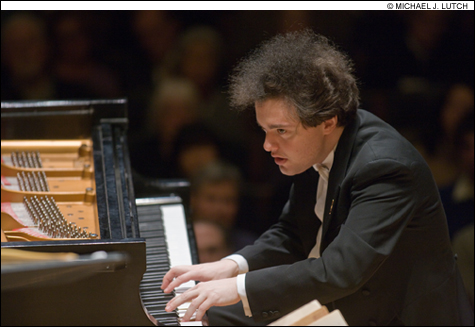
BRAHMS BOY? Evgeny Kissin played with phenomenal dexterity and large-scale grandeur, but the
reflective and searching nature of Brahms’s Second Piano Concerto eluded him. |
The Boston Symphony Orchestra program for last week’s four concerts was a familiar one: a Brahms symphony (the Third) was followed by one or the other of Brahms’s two piano concertos. These works, in similar configurations, have all been heard at Symphony Hall within the last 18 months. Yet the concerts were sold out and greeted with vigorous enthusiasm. Even individual movements got their own smattering of applause. This series was organized to prepare for a new EMI recording, though who is actually going to release it and when is now in some doubt.
No doubt about the source of the excitement: BSO maestro James Levine was leading superstar Russian virtuoso Evgeny Kissin, at 36 still a romantic figure with his stiff Old World demeanor and haunted pallor. And if anyone alive today is equal to Brahms’s technical demands, it’s Kissin.
At the opening concert on April 8, however, the symphony plodded, and though Kissin played the late B-flat concerto, No. 2, with phenomenal dexterity and large-scale grandeur, he seemed to have no clue about the reflective and searching nature of the music. The piece sounded like Rachmaninov. The Andante is one of the glories of Brahms. It opens with a great cello solo, which Jules Eskin played with ravishing and glowing warmth. But in this most emotionally and intellectually but least technically challenging section of the concerto, Kissin merely hit all the notes. Still, he wowed the audience, and after being called back repeatedly, he played Chopin’s charming “Minute” Waltz (though with only the barest hint of charm). Did it matter that Chopin had no connection with the rest of the program? At least on the following night, I was told, one of his two encores was a Brahms waltz (along with a Chopin scherzo).
By the end of the week, despite some ragged edges, the Third Symphony had come to life. Practically spinning on his new swivel chair, Levine seemed more animated, and Brahms’s most dancelike symphony had more lilt and more urgency — subtle little rhythmic swells (especially in the melancholy waltz of the minor-key third movement) that thrust each phrase forward. William R. Hudgins shone in the extensive passages for solo clarinet. And the early D-minor concerto, No. 1, with which Brahms struggled so hard (should it be a piano piece, and if so, for how many pianos? should it be a symphony?), with its even greater bravura and fewer demands for “interpretation,” was more up Kissin’s alley. His playing still had some fussy little self-conscious moments, but the size, agility, and color coordination were breathtaking. His encores were more Chopin — both in C-sharp minor: the ambitious Scherzo (with its solemn chords and feathery descent of heavenly snowflakes played with so much emphasis on texture and color, it sounded more like Liszt) and the famous little Waltz (which had so little ¾-time “lift,” it sounded more like a nocturne).